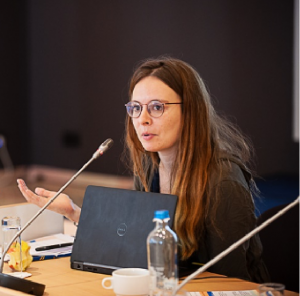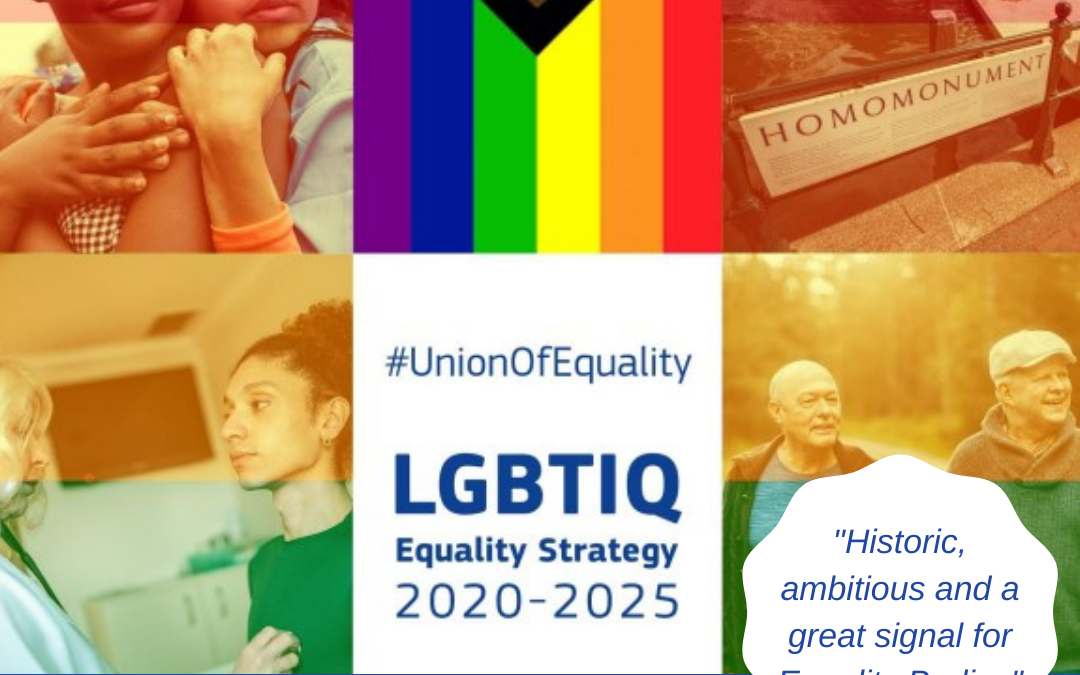Historic, Ambitious and A Great Signal for Equality Bodies: Discussing the first-ever EU LGBTIQ Strategy

By Moana Genevey, Policy Officer (Gender) at Equinet
On 11 November 2020, the European Commission adopted the first-ever LGBTIQ Strategy. Following the List of Actions for Advancing LGBTI Equality (2015-19), the Strategy is a long-awaited document which holds a stronger political value. This blogpost examines why this is a powerful signal sent by the Commission on achieving equality for LGBTIQ people, and great news for the future of equality bodies.
It’s a landmark! And an ambitious one
In the (small) world of EU equality defenders, the release of the LGBTIQ Strategy was a major milestone. For the first time ever, the European Commission is pledging to protect LGBTIQ people with a strong and comprehensive political document. While some Member States are frontally attacking LGBTIQ rights, the Commission is putting together policies to protect those very rights.
It is undeniable: the Strategy, by itself, is a landmark. But when analysing its content, it also appears to hold ambitious promises. For instance, the Strategy covers crucial fields which resonate with our times. It goes from protecting trans people from discrimination caused by facial recognition AI systems, to delivering training to health professionals for ensuring better health equality for LGBTI people. One remarkable promise made by the Commission is to propose legislation supporting the mutual recognition of parenthood between Member States. Building on the Coman Case (which recognised that the term ‘spouse’ under EU freedom of movement law includes same-sex spouses), this legislative proposal would improve the legal protection of rainbow families in cross-border situations. If introduced, this legislation could constitute a major step towards an EU-wide recognition of LGBTIQ families (even if family law remains a competence held by Member States).
We can now dare to dream about a Union which celebrates same-sex unions everywhere, where intersex children are not mutilated and where trans people can safely receive the health and administrative care they need. These outstanding developments show that the European Commission is positioning itself to be a leader on achieving LGBTIQ equality. And in this quest, equality bodies will be at the forefront.
A Union of Equality (Bodies)
The very first measure of the Strategy is to improve the enforcement of existing legal protection against discrimination. The Commission announces that it will be done through reporting on the application of the Employment Equality Directive (which protects LGB people against discrimination at work). Improved enforcement of EU law could also be achieved by putting forward new legislation on the role of equality bodies, by 2022.
Indeed, in 2000, the two Equal Treatment Directives (the so-called Race Equality Directive and the Employment Directive) gave birth to a comprehensive legal system of protection against discrimination in the EU. This system included the creation of independent public institutions tasked to carefully monitor and enforce the Equal Treatment Directives at national level: the equality bodies were born. Since then, equality bodies have developed their mandates and grounds of protection as EU legislation evolved, Equinet was created and the European Commission issued a Recommendation on Standards for Equality Bodies. Throughout the years, it became evident that equality bodies were an EU good practice for achieving equality, including LGBTIQ equality. They are institutional mechanisms on which the European Commission can rely on to, for instance, directly assist victims of discrimination, collect data, advise policymakers or promote equality all over Europe. It makes sense that the Commission wishes to further strengthen them, especially since equality is a driving value for Von Der Leyen’s Commission (as exemplified by the nomination of Helena Dalli, EU’s first ever Equality Commissioner).
This ambition to put equality bodies at the forefront has become visible over the past months, as the EU Action Plan Against Racism and the EU Roma Strategic Framework, two major EU equality policies, also alluded to introducing new legislation for equality bodies. But how exactly can stronger equality bodies help achieve LGBTI equality?
Stronger equality bodies make better LGBTIQ allies
Public institutions such as equality bodies are not immune from crisis. Economic crisis can dramatically affect their budget and human resources, while drastic political change can impact their independence, their activities or even their ability to function. This is why equality bodies need effective standards which protect their resources, independence and mandate regardless of the economic or political context.
Because stronger equality bodies make stronger allies for the LGBTIQ community. In general, equality bodies carry out extensive work on LGBTIQ equality. But, without a high standard of independence, one can doubt that the Polish Commissioner would have been able to challenge the legality of 9 so-called “LGBT free zones” in Poland. Without adequate resources, the German Federal Anti-Discrimination Agency would certainly not be able to carry out essential research projects on intersex persons at work. As discussed during our seminar on building bridges with trans & intersex activists, equality bodies can also complement and enhance the work of civil society organisations, while strategically assisting LGBTIQ activists. Yet, major challenges identified in our discussion paper on trans and intersex equality are underfunding of equality bodies, tense political context and the absence of a mandate to deal with this issue.
I am certain that, if given the appropriate means, and if granted proper independence, equality bodies can accomplish wonders for LGBTIQ equality. They need to be strengthened by EU legislation to unlock their full potential and better protect lesbian, gay, bisexual, trans, intersex and queer people around Europe. Looking at the LGBTIQ Strategy, this does not feel like wishful thinking anymore.
The views on this blog are always the authors’ and they do not necessarily reflect Equinet’s position.

